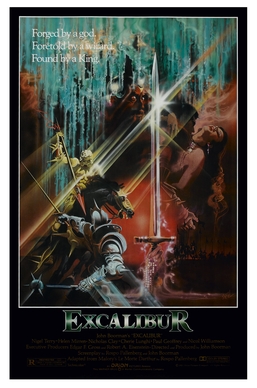Excalibur is the legendary sword of King Arthur, sometimes attributed with magical powers or associated with the rightful sovereignty of Great Britain. Sometimes Excalibur and the Sword in the Stone (the proof of Arthur's lineage) are said to be the same weapon, but in most versions they are considered separate. The sword was associated with the Arthurian legend very early. In Welsh, the sword is called Caledfwlch; in Cornish, the sword is called Calesvol.

In popular fiction, the two are often made as the same, such as in the film Excalibur
 , as well as the Disney film adaptation of The Sword in the Stone. The novel itself does present the swords as separate.
, as well as the Disney film adaptation of The Sword in the Stone. The novel itself does present the swords as separate.In Arthurian romance, a number of explanations are given for Arthur's possession of Excalibur. In Robert de Boron's Merlin, Arthur obtained the throne by pulling a sword from a stone. In this account, the act could not be performed except by "the true king," meaning the divinely appointed king or true heir of Uther Pendragon.
This sword is thought by many to be the famous Excalibur, and its identity is made explicit in the later so-called Vulgate Merlin Continuation, part of the Lancelot-Grail cycle.
However, in what is sometimes called the Post-Vulgate Merlin, Excalibur was given to Arthur by the Lady of the Lake sometime after he began to reign.
She calls the sword "Excalibur, that is as to say as Cut-steel." In the Vulgate Mort Artu, Arthur orders Griflet to throw the sword into the enchanted lake. After two failed attempts (as he felt such a great sword should not be thrown away), he finally complies with the wounded king's request and a hand emerges from the lake to catch it, a tale which becomes attached to Bedivere instead of Malory and the English tradition.
Malory records both versions of the legend in his Le Morte d'Arthur, naming both swords as Excalibur.

The challenge of drawing a sword from a stone also appears in the Arthurian legends of Galahad, whose achievement of the task indicates that he is destined to find the Holy Grail.
whose achievement of the task indicates that he is destined to find the Holy Grail.
 whose achievement of the task indicates that he is destined to find the Holy Grail.
whose achievement of the task indicates that he is destined to find the Holy Grail.
The story of the Sword in the Stone has an analogue in some versions of the story of Sigurd (the Norse proto-Siegfried), whose father, Sigmund, draws the sword Gram out of the tree Barnstokkr where it is embedded by the Norse god Odin.
In several early French works such as Chrétien de Troyes' Perceval, the Story of the Grail and the Vulgate Lancelot Proper section, Excalibur is used by Gawain, Arthur's nephew and one of his best knights. This is in contrast to later versions, where Excalibur belongs solely to the king
Excalibur is by no means the only weapon associated with Arthur, nor the only sword. Welsh tradition also knew of a dagger named Carnwennan and a spear named Rhongomyniad that belonged to him. Carnwennan ("Little White-Hilt") first appears in Culhwch and Olwen, where it was used by Arthur to slice the Very Black Witch in half. Rhongomyniad ("spear" + "striker, slayer") is also first mentioned in Culhwch, although only in passing; it appears as simply Ron ("spear") in Geoffrey's Historia. In the Alliterative Morte Arthure, a Middle English poem, there is mention of Clarent, a sword of peace meant for knighting and ceremonies as opposed to battle, which was stolen and then used to kill Arthur by Mordred. The Prose Lancelot of the Vulgate Cycle mentions a sword called Seure, which belonged to the king but was used by Lancelot in one battle.
No comments:
Post a Comment